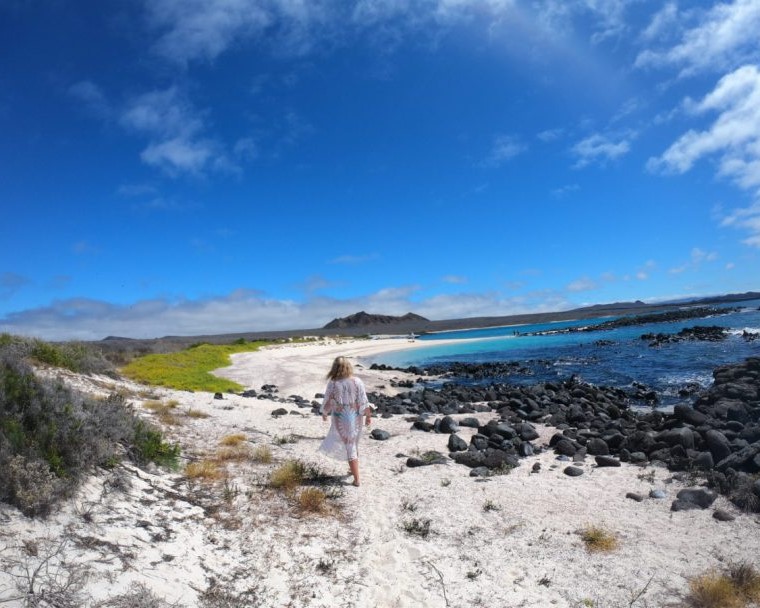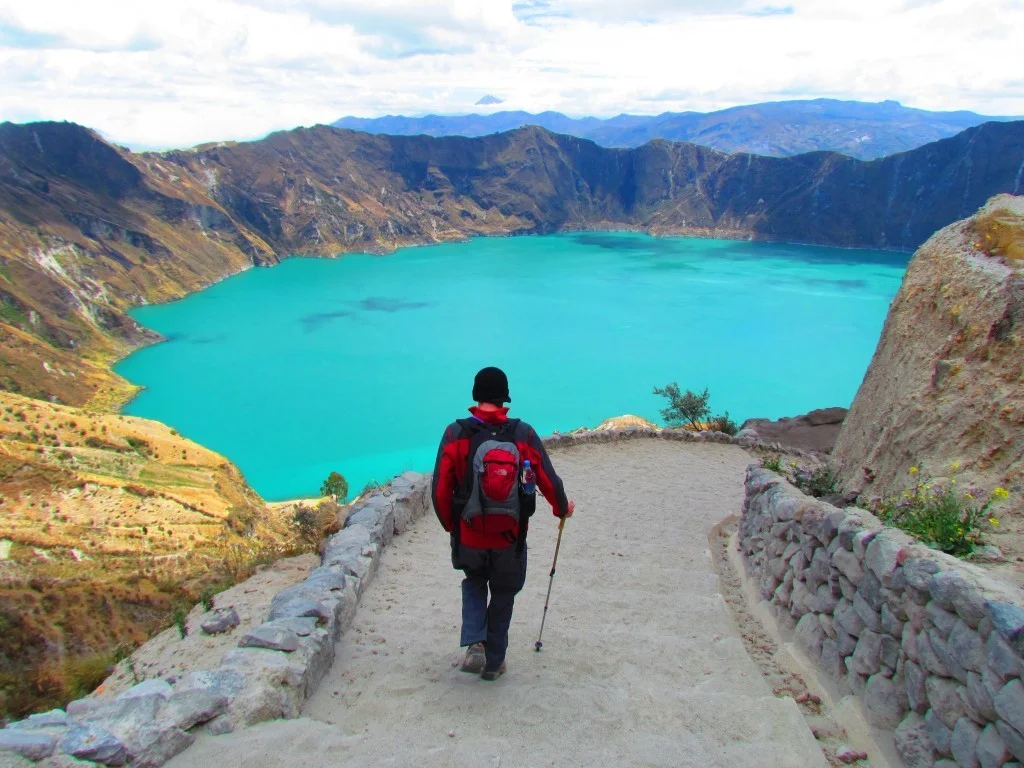Imagine stepping onto a pristine beach where the sand is as white as sugar, the waters are a vibrant turquoise, and the wildlife is as fearless as it is fascinating. Welcome to the beaches in Galápagos, a haven for nature lovers and adventure seekers alike. These islands are not just a sanctuary for unique wildlife, but also home to some of the most breathtaking beaches in the world.
The Galápagos Islands offer an unparalleled experience with their stunning landscapes and diverse ecosystems. Whether you’re an avid snorkeler eager to swim alongside sea turtles and marine iguanas or a beachcomber looking to relax on secluded shores, the Galápagos have something for everyone. The islands’ beaches are a blend of beauty and serenity. Providing the perfect escape from the hustle and bustle of daily life.
In this traveler’s guide, we’ll explore the very best of what these islands have to offer. From the famous Tortuga Bay on Santa Cruz Island. Renowned for its striking scenery and diverse marine life. To the secluded shores of Cerro Brujo on San Cristobal Island, each beach promises a unique and unforgettable experience. We’ll also provide insights into how you can make the most of your visit. Including tips on where to stay and how to navigate the islands efficiently.
So, get ready to embark on a journey through the best beaches in the Galápagos. Let the natural wonders of Ecuador’s most iconic archipelago captivate your senses. Discover why these beaches are a must-visit for any traveler. Continue reading to uncover the secrets of these extraordinary coastal treasures.
Top Beaches to Visit in the Galápagos Islands
The Galápagos Islands are home to some of the most breathtaking beaches in the world. Each beach offers a unique experience. From the pristine white sands of Tortuga Bay to the remote beauty of Cerro Brujo. Whether you’re seeking adventure or relaxation, these beaches should be on every traveler’s itinerary.
In this section, we’ll explore the top beaches in the Galápagos. Highlighting their unique features, activities, and the best times to visit. Get ready to discover the natural wonders of these extraordinary coastal treasures.
Tortuga Bay
Located on Santa Cruz Island, Tortuga Bay is renowned for its stunning scenery and diverse marine life. The beach is divided into two sections: Playa Brava, known for its strong currents and popular among surfers. And Playa Mansa, a calm bay ideal for swimming and snorkeling. Visitors can expect to see marine iguanas, sea turtles, and even baby sharks in the lagoon.
The best time to visit Tortuga Bay is during the early morning or late afternoon to avoid the crowds. It’s accessible via a 30-minute walk from Puerto Ayora. Making it a convenient day trip for those staying on Santa Cruz Island.
Cerro Brujo
Cerro Brujo, located on San Cristobal Island, is a remote and picturesque beach that offers a serene escape. The fine white coral sand and turquoise waters create a perfect backdrop for relaxation. Visitors can enjoy swimming alongside sea lions and marine iguanas. Or simply take in the breathtaking views of the surrounding landscape.
This beach is best visited during the dry season, from June to December. When the weather is cooler and less humid. Access is typically via a guided tour, ensuring a peaceful experience away from the crowds.
Gardner Bay
On Española Island, Gardner Bay is a long stretch of white sand beach inhabited by a large colony of sea lions. The calm waters make it an excellent spot for swimming and snorkeling. Where you can encounter sea turtles, reef sharks, and colorful fish.
Gardner Bay is often visited as part of a Galápagos cruise or a day trip from San Cristobal Island. The best time to visit is during the warm season, from December to May. When the sea conditions are ideal for snorkeling.
Unique Features of Galápagos Beaches
The beaches in Galápagos are not just a sight to behold. They are ecological marvels that showcase the unique interplay between geology and biology. These beaches are a testament to the volcanic origins of the islands. They are home to a diverse array of ecosystems that support rare and endemic species. Visitors to these shores are treated to a natural spectacle unlike any other.
The Galápagos Islands, formed by volcanic activity millions of years ago, offer a landscape that is both rugged and beautiful. The beaches here are characterized by their distinct geological formations, ranging from black volcanic rocks to pristine white sands. These formations provide a unique habitat for a variety of species, many of which are found nowhere else on Earth.
Volcanic Landscapes and Geological Formations
The geological history of the Galápagos Islands is written in the sands and rocks of its beaches. Each island has its unique volcanic features, such as the striking Pinnacle Rock on Bartolome Island or the red sands of Rabida Island. These formations are not only visually stunning but also play a crucial role in shaping the ecosystems of the islands.
For instance, the lava fields and rocky outcrops provide nesting grounds for marine iguanas and seabirds, while the sandy beaches serve as nesting sites for sea turtles. The volcanic soil enriches the surrounding waters, supporting a rich marine life that includes colorful fish, sea lions, and even penguins.
Diverse Ecosystems and Rare Species
The Galápagos beaches are teeming with life, offering a glimpse into the islands’ rich biodiversity. The beaches are home to an array of species that have adapted to the unique conditions of the islands. Visitors can observe marine iguanas basking on the rocks, sea lions lounging on the sands, and blue-footed boobies performing their courtship dances.
These ecosystems are fragile and require careful management to ensure their preservation. Conservation efforts are in place to protect these unique environments, including restrictions on human activity and the introduction of invasive species. The Galápagos National Park and the Charles Darwin Foundation work tirelessly to maintain the ecological balance of the islands.
Conservation Efforts and Environmental Protection
Conservation is at the heart of the Galápagos Islands’ appeal. The unique environments of the beaches are protected by strict regulations that aim to preserve their natural beauty and ecological significance. Visitors are encouraged to follow guidelines that minimize their impact on the environment, such as staying on designated paths and avoiding contact with wildlife.
Efforts to protect the islands extend beyond the beaches. The Galápagos Marine Reserve, one of the largest marine protected areas in the world, safeguards the waters surrounding the islands, ensuring that the rich marine biodiversity is preserved for future generations. These conservation measures are critical in maintaining the delicate balance of the Galápagos ecosystems.
For more information on how you can contribute to the conservation efforts during your visit, explore the resources provided by the Galápagos National Park and the Charles Darwin Foundation. By understanding and respecting the unique features of the beaches in Galápagos, you can help preserve these natural wonders for years to come.
Planning Your Galápagos Beach Adventure
Embarking on a journey to the beaches in Galápagos is an adventure like no other. With its unique blend of breathtaking landscapes and diverse wildlife, planning your trip requires a bit of preparation to ensure a seamless and unforgettable experience. From choosing the right time to visit to packing the essentials, this guide will help you make the most of your Galápagos beach adventure.
Whether you’re a seasoned traveler or a first-time visitor, knowing what to expect and how to prepare can make all the difference. Here, we provide you with practical tips and recommendations to help you plan your trip effectively, so you can focus on enjoying the stunning beaches and vibrant ecosystems of the Galápagos Islands.
Best Time to Visit
The Galápagos Islands are a year-round destination, but the best time to visit depends on your interests. The warm season, from December to May, offers calm seas and ideal snorkeling conditions, while the dry season, from June to November, is perfect for wildlife enthusiasts eager to see unique species in their natural habitats.
During the warm season, temperatures range from 24°C to 31°C (75°F to 88°F), making it perfect for beach activities. The dry season, with cooler temperatures and less humidity, is ideal for hiking and exploring the islands’ diverse landscapes.
Packing Essentials
To ensure a comfortable and enjoyable trip, pack wisely. Here’s a checklist to help you prepare:
- Lightweight Clothing: Opt for breathable fabrics to stay cool in the tropical climate.
- Sun Protection: Bring sunscreen, a wide-brimmed hat, and sunglasses to protect yourself from the intense sun.
- Snorkeling Gear: Although rentals are available, bringing your own ensures a perfect fit and comfort.
- Waterproof Bag: Keep your electronics and valuables safe from water and sand.
- Comfortable Footwear: Pack both sandals for the beach and sturdy shoes for hiking.
Travel Agencies and Accommodations
Choosing the right travel agency and accommodation can enhance your Galápagos experience. Consider booking with reputable agencies that offer guided tours and packages tailored to your interests. This ensures you have access to expert knowledge and insights about the islands.
For accommodations, the islands of Santa Cruz, San Cristobal, and Isabela offer a range of options from budget-friendly hostels to luxury hotels. Staying on these islands provides easy access to the most popular beaches and attractions.
For more information on planning your Galápagos adventure, explore our travel resources and recommendations on our website. Whether you’re seeking relaxation or adventure, the Galápagos Islands promise an unforgettable journey.
Embark on Your Galápagos Beach Journey
The beaches in Galápagos are more than just picturesque landscapes; they are gateways to a world of natural wonder and adventure. From the tranquil shores of Tortuga Bay to the secluded beauty of Cerro Brujo, each beach offers a unique experience that captivates the senses and invigorates the spirit. Whether you’re snorkeling with sea turtles at Gardner Bay or basking under the equatorial sun on the sands of Española Island, these beaches promise unforgettable memories.
As you plan your visit to these extraordinary shores, remember that timing and preparation are key. The Galápagos Islands are a year-round destination, with the warm season providing ideal conditions for water activities and the dry season offering cooler temperatures for exploring the islands’ diverse landscapes. Pack wisely with essentials like sunscreen, snorkeling gear, and comfortable footwear to ensure a seamless adventure.
Beyond the breathtaking scenery and vibrant wildlife, the beaches in Galápagos are also a testament to the islands’ commitment to conservation. Visitors are encouraged to respect the environment by following guidelines that protect these fragile ecosystems. By doing so, you not only enhance your own experience but also contribute to the preservation of this unique archipelago for future generations.
Ready to start your Galápagos adventure? Visit our website at Boutique Hotel Mansión Alcázar for more travel tips and inspiration. Whether you’re a seasoned traveler or embarking on your first island getaway, the Galápagos Islands await with open arms. So pack your bags, embrace the spirit of exploration, and let the natural beauty of these beaches guide your journey.




